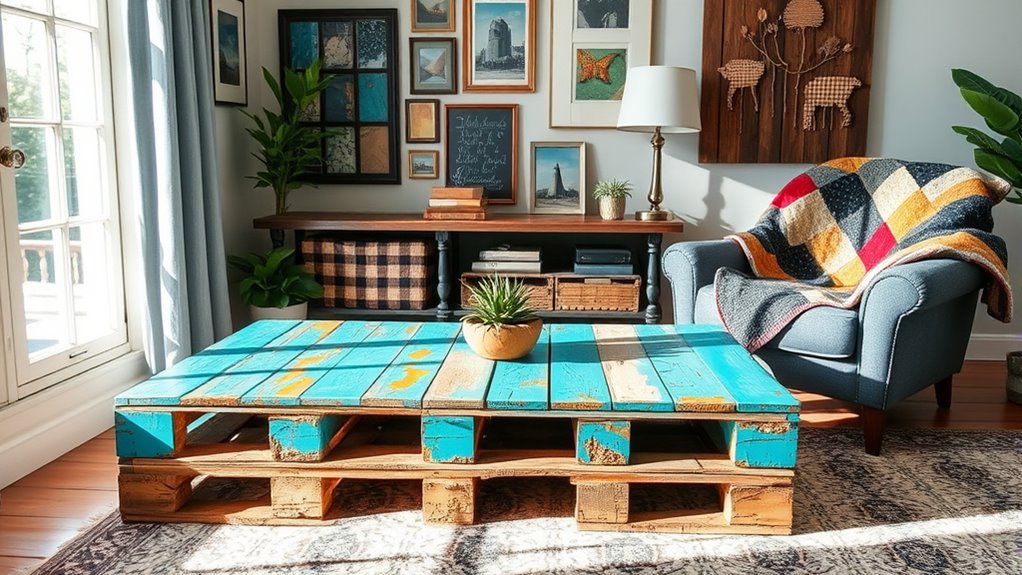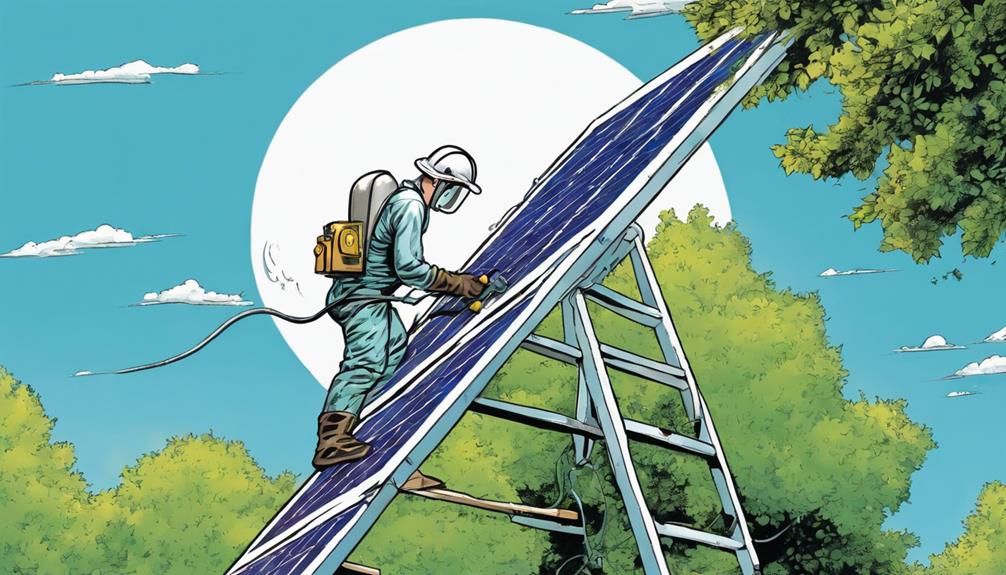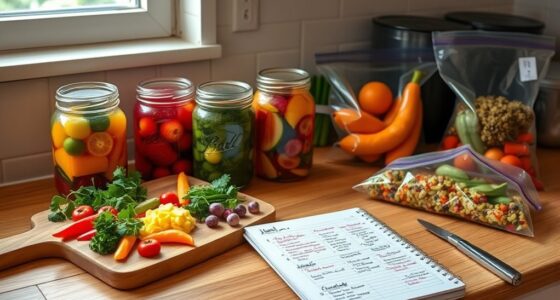This weekend, you can transform your home with easy upcycled décor ideas like creating a gallery wall with vintage postcards or fabric swatches, repainting old furniture for a fresh look, or turning discarded items into stylish accents such as trunks as coffee tables or ladders as shelves. Incorporate eco-friendly methods by repurposing materials and choosing sustainable projects. If you explore more, you’ll find plenty of creative ways to personalize your space while helping the environment.
Key Takeaways
- Create a gallery wall using vintage postcards or fabric swatches for personalized wall art.
- Repaint and repurpose old furniture, like chairs or tables, for stylish, cost-effective updates.
- Transform discarded items such as ladders or trunks into charming shelves or coffee tables.
- Incorporate eco-friendly materials like shells or buttons to add texture and sustainability to your décor.
- Use leftover fabrics or magazines to craft colorful wall hangings and textured art pieces.

Transforming old or discarded items into stylish home décor is a creative way to add personality to your space while reducing waste. This weekend, you can breathe new life into your home by exploring upcycled décor ideas that are both fun and eco-friendly. Start with DIY wall art—it’s a simple project that can dramatically change a room’s vibe. Gather some leftover wood, old magazines, fabric scraps, or even vintage plates. Use these materials to craft unique pieces that reflect your style. For example, you could create a gallery wall by framing vintage postcards or fabric swatches, or make a textured piece by gluing assorted buttons or shells onto a canvas. The key is to think outside the box and personalize your art to match your aesthetic. DIY wall art not only costs less than store-bought décor but also offers a satisfying creative outlet. Incorporating upcycling principles into your projects helps support sustainability and reduces environmental impact, making your décor both stylish and eco-conscious.
Next, consider repurposed furniture. Instead of tossing out that tired table or chair, give it a fresh coat of paint and transform it into a statement piece. An old ladder can become a charming bookshelf, while a worn-out dresser can serve as stylish storage with a little sanding and new hardware. The beauty of repurposed furniture lies in its uniqueness—each piece carries a history that adds character to your home. You can also adapt furniture to new functions; for example, turning a vintage trunk into a coffee table or an antique door into a headboard. These projects require minimal tools and materials, making them accessible for weekend DIYers. Plus, repurposed furniture not only saves money but also reduces environmental impact, aligning your décor choices with sustainability.
Getting creative with upcycled décor doesn’t have to be complicated. Combine DIY wall art with repurposed furniture for a cohesive look, or focus on one project at a time. For example, you might start by revamping a side table and then move on to making a colorful wall hanging using leftover fabric. These projects can be completed in a single weekend and give your space a fresh, personalized touch. Remember, the process is just as important as the final result—your effort and creativity turn discarded items into cherished home accents. With a little imagination, you can craft a space that’s both stylish and environmentally conscious, all while enjoying the satisfaction of creating something uniquely yours. So, grab your supplies, set aside the weekend, and start transforming your home into a reflection of your personality through upcycled décor.
Frequently Asked Questions
What Tools Are Essential for Upcycling Home Décor?
When you’re exploring tools for upcycling home décor, focus on essentials like paintbrushes, sanders, and staple guns to help with recycling techniques. You’ll also need scissors, glue guns, and screwdrivers for assembling decorative accents. These tools make it easier to transform old items into fresh, stylish pieces, ensuring your upcycling projects turn out beautifully. With the right tools, you can confidently create unique, eco-friendly home accents that reflect your personal style.
How Do I Choose the Right Materials to Upcycle?
When choosing the right materials to upcycle, you should focus on recycling techniques and material sourcing. Look for items that have good potential for transformation, like old furniture, jars, or fabric scraps. Consider their durability and how well they’ll work with your design ideas. You’ll want to source materials locally or creatively repurpose what you already have, ensuring each piece is sustainable and fits your style perfectly.
Are There Eco-Friendly Paints Suitable for Upcycling Projects?
You might think all paints are eco-friendly, but many contain harmful chemicals. Luckily, there are eco-friendly paints and non-toxic finishes perfect for your upcycling projects. These options reduce environmental impact and keep your space healthier. By choosing non-toxic finishes, you guarantee your creations are safe for your home and the planet. So, always look for products labeled eco-friendly or non-toxic to make smarter, greener choices in your DIY endeavors.
How Can I Ensure My Upcycled Décor Is Durable?
To guarantee your upcycled décor is durable, focus on proper surface preparation, using eco-friendly paints suited for your project, and applying multiple coats for longevity. Don’t fall for recycling myths that suggest all upcycled items are fragile; with the right techniques, they can be sturdy. Stay updated on upcycling trends that emphasize quality and sustainability, making your décor both beautiful and long-lasting.
What Safety Precautions Should I Take During Upcycling?
Oh, because who doesn’t love risking it all with sharp tools and old paint? You should wear safety gear like gloves and goggles, even if you think you’re invincible. Make sure to work in a well-ventilated space—crucial when handling fumes or dust. And don’t skip safety precautions; they’re your best friends in avoiding injuries and ensuring your upcycling adventure stays fun, not dangerous.
Conclusion
So, this weekend, let your creativity blossom like a wild garden, transforming everyday items into stunning treasures. Embrace the magic of upcycling—turning discarded into desired, chaos into charm. With each piece you craft, you’re weaving a story of sustainability and style, a symphony of imagination and purpose. Immerse yourself, get your hands dirty, and watch your home become a gallery of your eco-friendly artistry. Your space, like your spirit, will shine brighter with every upcycled touch.










